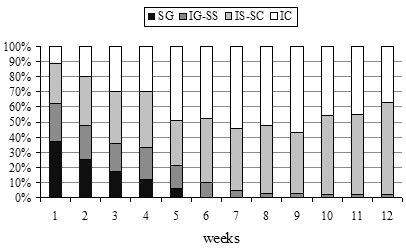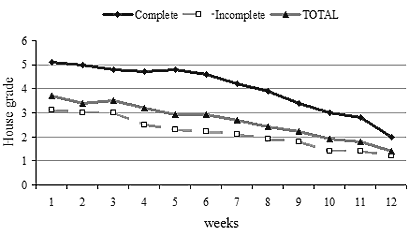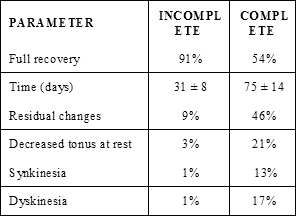

|
Journal Home Contents Preview Next |
Pro Otology
Balkan Journal of Otology & Neuro-Otology, Vol. 3, No 1:35-38 © 2003
All rights reserved. Published by Pro Otology Association
Recovery Rate of Peripheral Facial Palsy.
The Value of Impedance Audiometry.
*I. Stankovic, *Z. Kojovic, ÜM. Stankovic
*Clinic for Physical Medicine and Rehabilitation,
ÜORL Clinic, Medical Faculty Nis, Serbia, Yugoslavia
ABSTRACT
Hypothesis: Besides topodiagnostic importance stapedial reflex testing is reliable for study of facial nerve recovery.
Background: Different tests are used for evaluation of facial recovery without presence of completely easy and reliable method.
Methods: Study comprised 48 patients with facial palsy, 17 with complete, and 31 with incomplete. Patients were treated with corticosteroids, kinesi therapy, electrophoresis, electrostimulation and thermal therapy. The success of recovery was estimated clinically, using impedance audiometry and electroneurography.
Results: Excellent recovery of facial function was present in 91% of incomplete, and in 54% of complete palsy. Reappearance of stapedial reflex correlated to the clinical recovery of nerve. After the therapy stapedial reflex was present in 89%, and other patients had elevated threshold, irregular or absent reflexes. The reliability of stapedial reflex for prognosis of facial recovery was good. This test should be used with other methods for evaluation of facial recovery, and study the effect of therapy of peripheral facial palsy, because it is simple and reliable.
Conclusions: Impedance audiometry is the simplest and easily accepted test for facial palsy, when compared to other clinical prognostic methods, with a good correlation to the course of facial palsy, recovery rate and the results of treatment. This approves itís routine use in cases with idiopathic peripheral facial palsy.
Key words: Peripheral facial palsy, Impedance audiometry, Physical therapy.
Pro Otology 1: 35-38, 2003
INTRODUCTION
Facial nerve damage can occur at supranuclear, nuclear and peripheral level. Idiopathic, or Bellís palsy is the most frequent type of peripheral lesions, comprising about 70% of them. Traumatic, herpetic, otogenic, or neoplastic types of palsy are rare (1).
Few clinical methods are used for estimation of facial nerve condition, recovery rate and the effects of therapy. They include: clinical analyse, topodiagnostics (lacrimation test, salivation, gustometry, stapedial reflex testing), electrophysiologic tests (electromiography, electroneurography, trigemino facial reflex), radiography and others(2,3).
There are no universally accepted opinions concerning value of each applied test for control and estimation of facial recovery (4,6).
The aim of this study was a) to evaluate the course of facial nerve recovery and b) to investigate the reliability of stapedial reflex for prognosis of recovery and the effects of physical therapy of peripheral facial palsy.
METHODS
Prospective clinical study that included 48 patients with idiopathic peripheral facial palsy was conducted. The patients were treated between 1996 and 2001 in ENT Clinic and Clinic for Physical Therapy and Rehabilitation in Nis. They were clinically examined at onset of palsy, and after that on each seventh day, until the end of treatment. Facial palsy was analysed according to House criteria (7). Routine laboratory analyses, audiometry, electroneurography, and topodiagnostic tests were performed (lacrimation, impedance audiometry and gustatory testing). Impedance audiometry was done on Madsen ZO 2020 apparatus, each seventh day. Presence of acoustic reflex, threshold, regularity and absence of reflex were documented.
Physical therapy included: kinesi therapy, electrophoresis, electrotherapy, and thermal procedures. Electrostimulation of nerve was performed with galvanic current, bipolar technique with 70 stimulations of each motor point, 16 mA. Corticosteroids, vasodilatators and vitamins in usual clinical doses were also given.
Spectorís criteria were used for evaluation of facial recovery, with symmetry, muscle tone, voluntary movements and synkinesia as relevant parameters (8). Recovery was grades as excellent, well, sufficient, marginal, or bad. Statistical study with students t test and χ2 test was performed.
|
Histogram 1. Time course of idiopathic peripheral facial palsy (SG= suprageniculate, IG-SS = infrageniculate suprastapedial, IS-SC = infrastapedial suprachordal, IC = infrachordal palsy). |

|
RESULTS
Thirty three patients out of total 48 were female. Average age amounted 31,7 years. Complete palsy was verified in 17 patients, and incomplete in other 31. Tonal audiometry and laboratory tests were normal in all the subjects.
Topodiagnostic tests indicated that in the beginning the most of palsies were suprastapedial, with gradual predominance of infrastapedial affection (Histogram 1).
Impedance audiometry revealed the initial absence of stapedial reflex in 62% of patients, and irregularity or elevated threshold in other patients.
After the end of therapy excellent facial recovery was found in 91% of incomplete, and in 54% of complete palsy. Residual changes were found in other patients (Table 1). Reappearance of stapedial reflex correlated to clinical recovery of nerve. After the therapy stapedial reflex was present in 89%, and other patients had elevated threshold, irregular or absent reflexes (FIG. 1).
The rate of facial nerve recovery according to type of palsy are presented in Histogram 2.
|
Histogram 2. Time course of recovery of idiopathic peripheral facial palsy. |

|
DISCUSSION
| Table 1. Recovery of peripheral idiopathic facial palsy |

|
Prognosis of facial recovery should predict the course and outcome of pathological process, and enable following of condition. Acute complete facial palsy is a disease where clinical tests are the most important. The first two weeks are especially decisive, because maximum of pathologic alterations is present in that period (1).
Average time to accomplish full recovery amounts 4,5 weeks (range 3-10 weeks) for incomplete, and 9,3 weeks (range 3-27 weeks) for complete palsy (9).
Reference data concerning recovery rate, prognosis and therapeutic effect in peripheral facial palsy are partly controversial. Full recovery is present in 73-85% cases of incomplete palsy without steroid therapy, and in 86-100% with steroid therapy. This difference found in literature is usually non significant. In cases of complete palsy full recovery is much lower, 38-46% without steroids, and 27-79% with steroids. Corticosteroid therapy is more effective if started during the first day of palsy (3,4).
Prognostic tests and their reliability are differently reported. They are mainly important for complete palsy where clinical follow up is not possible because of absent voluntary mimetic movements, and because of therapeutic importance. 1 Electric tests (electroneurography, evoked EMG, maximal stimulation test) are considered to be the most valuable for prognosis of recovery. Time span between the onset of a pathological process and possibility to register the changes is their main disadvantage (5,6). Salivary and lacrimation tests are less reliable than previous methods in study of facial palsy (2,10-13).

|
|
FIG 1. Impedance audiometry in peripheral facial palsy. Regular tympanogram, absent reflexes (left), in recovery period reflex can be irregular (right). |
The value of stapedial reflex for facial palsy is not equally estimated. Positive correlation between facial recovery and reappearance of reflex was found in some works. Early presence of reflex indicates on better restoration (1,3). On the other side, recovery of reflex was documented to be later than recovery of mimetic muscles, with false positive results. Middle ear function should be normal for reflex testing, so itís value is limited in cases of trauma. Stapedial reflex is present 10 days before muscular function is reestablished (2).
Facial rehabilitation should enable selective muscular control, symmetry, synchronicity of function and spontaneous expression. The ultimate aim is voluntary control of kinetic function of mimetic muscles. Clinical studies have documented improved recovery using electrophoresis, while electrostimulation prevented development of muscular atrophy (14,15).
This study confirmed that reappearance of stapedial reflex correlates with improvement of facial nerve function, and also the effects of physical therapy. Recovery process is usually accompanied by irregularities of reflex (aberrant type, decay, raised threshold). However, the incidence and intensity of stapedial reflex changes is not always adequate to facial nerve function, especially in cases with complete type of palsy. In general, prognostic value of stapedial reflex was good (sensitivity 82%, specificity 74%).
CONCLUSION
Impedance audiometry is the simplest and easily accepted test for facial palsy, when compared to other clinical prognostic methods, with a good correlation to the course of facial palsy, recovery rate and the results of treatment. This approves itís routine use in cases with idiopathic peripheral facial palsy.
REFERENCES
Dufour JJ. Facial Nerve Function and Assesment. In: Alberti PW, Ruben RJ, eds. Otologic Medicine and Surgery. New York: Churchill Livingstone, 1988;523-42.
Hughes G. Prognostic Tests in Acute Facial Palsy. Am J Otol 1989;10:304-8.
Brown JS. Bellís Palsy. A 5 Year Review of 174 Consecutive Cases. An Attempted Double Blind Study. Laryngoscope 1982;92:1369-73.
Burgess LPA, Yim DWS, Lepore ML. Bellís Palsy. The Steroid Controversy Revisited. Laryngoscope 1984;94:1472-6.
Joachims HZ, Bialik V, Elichar I. Early Diagnosis in Bellís Palsy. A Nerve Conduction Study. Laryngoscope 1980;90:1705-8.
Skevas AT, Danielides VG, Assimakoupoulos DA. The Role of the Facial Nerve Latency in the Prognosis of Bellís Palsy. Laryngoscope 1990;100:1083-5.
House JW, Brackmann DE. Facial Nerve Grading System. Otolaryngol Head Neck Surg 1985;93:146-7.
Spector GJ. Classification of Facial Nerve Disorders. Laryngoscope 1985;95:100-3.
Jonsson L, Sjoberg D, Thomander L. Depression of T Cells in Bellís Palsy. Ann Otol Rhinol Laryngol 1988;97:138-41.
Blanchaert RH. Surgical Management of Facial Nerve Injuries. Oral Maxillofac Surg Clin North Am 2001;9:43-58.
Bascom DA, Schaitkin BM, May M, et al. Facial Nerve Repair: A Retrospective Review. Facial Plast Surg 2000;16:309-13.
Nakao Y, Piccirillo E, Falcioni M, et al. Electromyographic Evaluation of Facial Nerve Damage in Acoustic Neuroma Surgery. Otol Neurotol 2001;22:554-7.
Jackler RK, Whinney D. A Century of Eighth Nerve Surgery. Otol Neurotol 2001;22:401-16.
Brudny J. Biofeedback in Chronic Neurological Cases. Therapeutic Electromyography, In: White L, Tursky B eds: Clinical Biofeedback. Efficacy and Mechanisms. New York:The Guilford Press, 1982.
Jungehulsing M, Guntinas-Lichius O, Stennert E. Rehabilitation in Chronic Facial Paralysis. HNO 2001;49:418-26.
|
Pro Otology |
Journal Home Contents Preview Next |